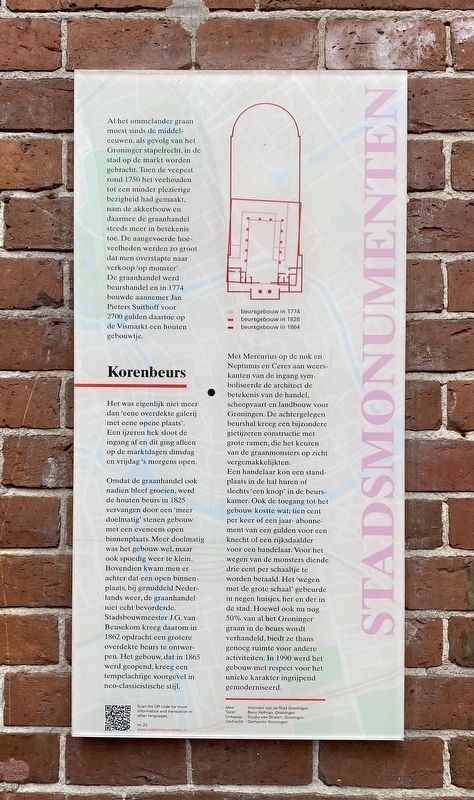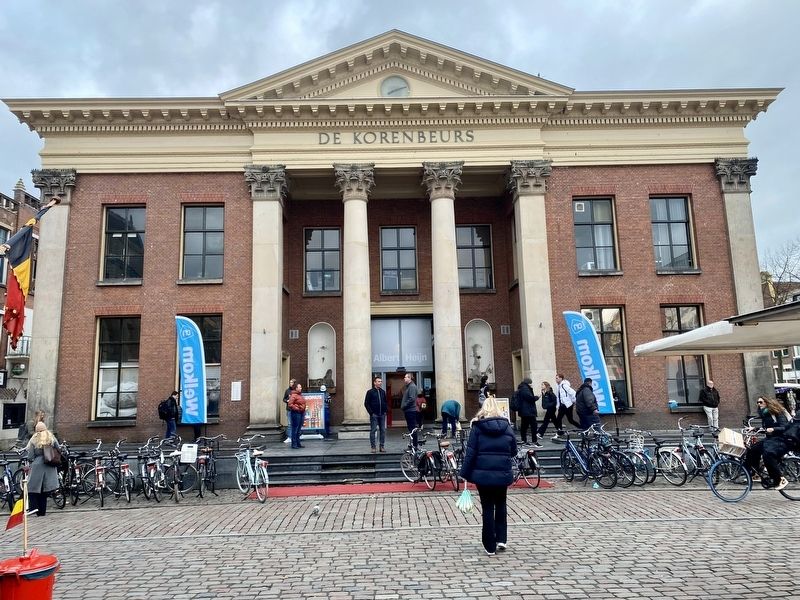Groningen, Netherlands — Northwestern Europe
Korenbeurs / Grain Exchange
— Stadsmonumenten —
Omdat de graanhandel ook nadien bleef groeien, werd de houten beurs in 1825 vervangen door een ‘meer doelmatig’ stenen gebouw met een eveneens open binnenplaats. Meer doelmatig was het gebouw wel, maar ook spoedig weer te klein. Bovendien kwam men erachter dat een open binnenplaats, bij gemiddeld Nederlands weer, de graanhandel niet echt bevorderde. Stadsbouwmeester J.G. van Beusekom kreeg daarom in 1862 opdracht een grotere overdekte beurs te ontwerpen. Het gebouw, dat in 1865 werd geopend, kreeg een tempelachtige voorgevel in neoclassicistische stijl. Met Mercurius op de nok en Neptunus en Ceres aan weerskanten van de ingang symboliseerde de architect de betekenis van de handel, scheepvaart en landbouw voor Groningen. De achtergelegen beurshal kreeg een bijzondere gietijzeren constructie met grote ramen, die het keuren van de graanmonsters op zicht vergemakkelijkten.
Een handelaar kon een standplaats in de hal huren of slechts ‘een knop’ in de beurskamer. Ook de toegang tot het gebouw kostte wat: tien cent per keer of een jaarabonnement van een gulden voor een knecht of een rijksdaalder voor een handelaar. Voor het wegen van de monsters diende drie cent per schaaltje te worden betaald. Het ‘wegen met de grote schaal’ gebeurde in negen huisjes, her en der in de stad. Hoewel ook nu nog 50% van al het Groninger graan in de beurs wordt verhandeld, biedt ze thans genoeg ruimte voor andere activiteiten. In 1990 werd het gebouw met respect voor het unieke karakter ingrijpend gemoderniseerd.
All the Ommelander grain had to be brought into the city market since the middle ages, due to the Groninger pile law. When dairy farming became a less enjoyable profession due to the cattle plague in 1750, the crops
and thus the grain trade became more important. The supply was so large that they switched to a selling "on sample" system. The grain trade became part of the exchange trading. In 1774 the contractor Jan Pieters Suithoff built a wooden building at the fish market for this purpose for 2700 guilders. It was nothing more than a "covered gallery with an open place". An iron gate locked the door and it was only open on Tuesday and Friday morning which were the market days.
Because the grain trade also continued to grow thereafter, the wooden structure was replaced by a "more effective" stone building with an open courtyard as well in 1825. The building was more efficient but it was soon too small again. Moreover, an open courtyard did not really work well with traditional Dutch weather. The city architect J. G. Van Beusekom was therefore commissioned to design a large indoor exhibition hall in 1825. The building which opened in 1865, had a temple-like facade in a neoclassic style. By placing mercury on the ridge and Neptune and Ceres on both sides of the entrance, the architect symbolized the meaning of trade, shipping, and agriculture for Groningen. The backside of the exhibition hall was given a special cast iron construction with large windows, which facilitated the testing of grain samples on sight.
A trader could rent a stand in the hall or just a "button" in the exhibition room. The access to the building also had a price, which was 10 cents per visit or an annual subscription of one guilder for a servant and a dollar for a trader. In order to weight the samples, 3 cents had to be paid per tray. Weightings with the big tray took place in 9 houses which were scattered around the city. Even though 50% of Groningen’s grain is still traded in the stock market, it still offers enough space for other activities. In 1990 the building was thoroughly modernized with respect for the uniqueness.
Erected by Gemeente Groningen. (Marker Number 23.)
Topics and series. This historical marker is listed in this topic list: Industry & Commerce. In addition, it is included in the Groningen Stadsmonumenten series list. A significant historical year for this entry is 1750.
Location. 53° 13.008′ N, 6° 33.828′ E. Marker is in Groningen. Marker is at the intersection of Akerhof and Vismarkt, on the left when traveling north on Akerhof. Touch for map. Marker is at or near this postal address: Akerkhof 1, Groningen 9711 JB, Netherlands. Touch for directions.
Other nearby markers. At least 8 other markers are within walking distance of this marker. Oprichting van de Loge / Establishment of I.O.O.F. Lodge (a few steps from this marker); Vereeniging van Groningen Handelaren / Groningen Merchants Association (1847 - 1992) (a few steps from this marker); Vismarkt 56 (a few steps from this marker); Sociaal Democratische Bond / Social Democratic Union (a few steps from this marker); Vismarkt 40 (about 90 meters away, measured in a direct line); A-Kerk / A-Church (about 120 meters away); Het Soephuis / The Soup House (about 150 meters away); Evert Jan Thomassen à Thuessink (about 180 meters away). Touch for a list and map of all markers in Groningen.
Credits. This page was last revised on December 31, 2023. It was originally submitted on February 2, 2023, by Andrew Ruppenstein of Lamorinda, California. This page has been viewed 42 times since then and 5 times this year. Photos: 1, 2. submitted on February 2, 2023, by Andrew Ruppenstein of Lamorinda, California.

